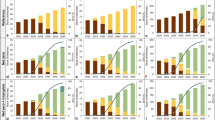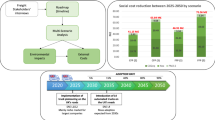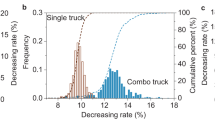Abstract
In this paper, we present a method to estimate CO2 reduction potential by increasing the truck size. Trucks are apparently the most preferred freight transport option for most shippers. Therefore, increasing the truck size may be a realizable and practical strategy, except when logistics companies (truck owners) tailor their truck sizes to customer needs despite their inefficiencies. However, increasing the truck size is not justified in all situations. Some types and sizes of trucks may fit specific distance ranges. The distance range in which a certain type and size of truck shows the highest efficiency can be determined by the break-even distance of the corresponding truck type/size. Using this information on break-even distances, the government can roughly estimate the potential CO2 savings. Based on a case study of only pallet shipping trucks, if a subsidy of a 10% discount of new truck purchase costs is given to 1,000 truck owners for 10 years to foster an increase in the sizes of their trucks, the net amount of CO2 emissions that can be saved by 2020 would be 103,069 t. Even though the quantity is not significant, the government expects that shippers and truck owners will more rationally select truck sizes if the information of the break-even distances is provided to the trucking market.
Similar content being viewed by others
References
Abate, M. and de Jong, G. (2014). “The optimal shipment size and truck size choice–The allocation of trucks across hauls.” Transportation Research Part A: Policy and Practice, Vol 59, pp. 262–277, DOI: 10.1016/j.tra.2013.11.008.
ATRI (2011). National petroleum council future transportation fuels study: truck demand group findings.
CE Delft (2003). To shift or not to shift that's the question, CEDelft, 03.4360.09.
EC (1999). Methodology for calculating transport emissions and energy consumption -MEET, Project Report SE/491/98.
EC (2014). Directives and regulations -motor vehicles <http://ec.europa.eu/enterprise/sectors/automotive/documents/directives/motor-vehicles/index_en.htm>.
FHWA (2012). Traffic recorder instruction manual: A, vehicle classification using FHWA 13-Category Scheme. Freight Transport Market Research Center in The Korea Transport Institute. http://roft.koti.re.kr/(Accessed Jan, 2015).
Guerrero, S. E., Madanat, S. M., and Leachman, R. C. (2013). “The trucking sector optimization model: A tool for predicting carrier and shipper responses to policies aiming to reduce GHG emissions.” Transportation Research Part E: Logistics and Transportation Review, Vol. 59, pp. 85–107, DOI: 10.1016/j.tre.2013.08.005.
Kim, N. S. and Van Wee, B. (2011). “The relative importance of factors that influence the break-even distance of intermodal freight transport systems.” Journal of Transport Geography, Vol. 19, No. 4, pp. 859–875, DOI: 10.1016/j.jtrangeo.2010.11.001.
Kim, N. S. and Van Wee, B. (2014). “Toward a better methodology for assessing CO2 Emissions for intermodal and truck-only freight systems: A european case study.” International Journal of Sustainable Transportation, Vol. 8, No. 3, pp. 177–201, DOI: 10.1080/15568318. 2011.633689.
Larsson, S. (2009). Weight and dimensions of heavy commercial vehicles as established by Directive 96/53/EC and the European Modular System (EMS), ACEA (European Automobile Manufactures Associaion).
Logistics Research Centre (2010). Measuring and managing CO2 emissions.
Mckinnon, A. C. (2003). Logistics and the Environment, in Hensher, D. A. & Button, K. J. (Eds.) Handbook of Transport and the Environment. Elsevier Ltd.
MLIT (Ministry of Land, Infrastructure, and Transport) (2013). Manual of data collection for road traffic <http://www.law.go.kr/admRulLsInfoP. do?admRulSeq=2000000023225#AJAX>.
Odhams, A. M. C., Roebuck, R. L., Lee, Y. J., Hunt, S. W., and Cebon, D. (2010). “Factors influencing the energy consumption of road freight transport.” Proceedings of the Institution of Mechanical Engineers, Part C: Journal of Mechanical Engineering Science, Vol. 224, No. 9, pp. 1995–2010.
Park, D., Kim, N.S., Park, H., and Kim, K. (2012). “Estimating trade-off among logistics cost, CO2 and time: A case study of container transportation systems in Korea.” Journal International Journal of Urban Sciences, Vol. 16, No. 1, pp. 85–98, DOI: 10.1080/12265934.2012.668322.
Rutten, B. J. C. M. (1995). On medium distance intermodal rail transport, Delft, Delft University of Technology.
Teo, J. S. E., Taniguchi, E., and Qureshi, A.G. (2014). “Multi-agent systems modelling approach to evaluate urban motorways for city logistics.” International Journal of Urban Sciences, Vol. 18, No. 2, pp. 154–165, DOI: 10.1080/12265934.2014.929020.
UKdft (2009). Definition of vehicle categories: Extracted from 2007/46/EC as last amended by 385/2009 http://www.dft.gov.uk/vca/vehicletype/definition-of-vehicle-categories.asp.
Woodrooffe, J., Glaeser, K.-P., and Nordengen, P. (2010). “Truck Productivity, Efficiency, Energy Use, and Carbon Dioxide Output: Benchmarking of International Performance.” Transportation Research Record: Journal of the Transportation Research Board, Vol. 2162, DOI: 10.3141/2162-08.
Author information
Authors and Affiliations
Corresponding author
Rights and permissions
About this article
Cite this article
Kim, N.S., Wiegmans, B. & Bu, L. Potential CO2 savings by increasing truck size: A Korean case study. KSCE J Civ Eng 20, 997–1005 (2016). https://doi.org/10.1007/s12205-016-2560-4
Received:
Accepted:
Published:
Issue Date:
DOI: https://doi.org/10.1007/s12205-016-2560-4




